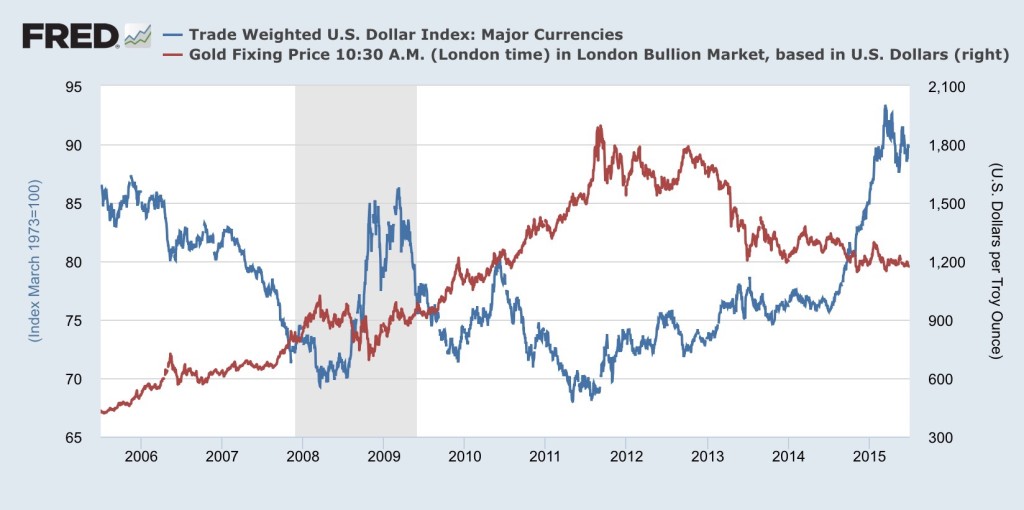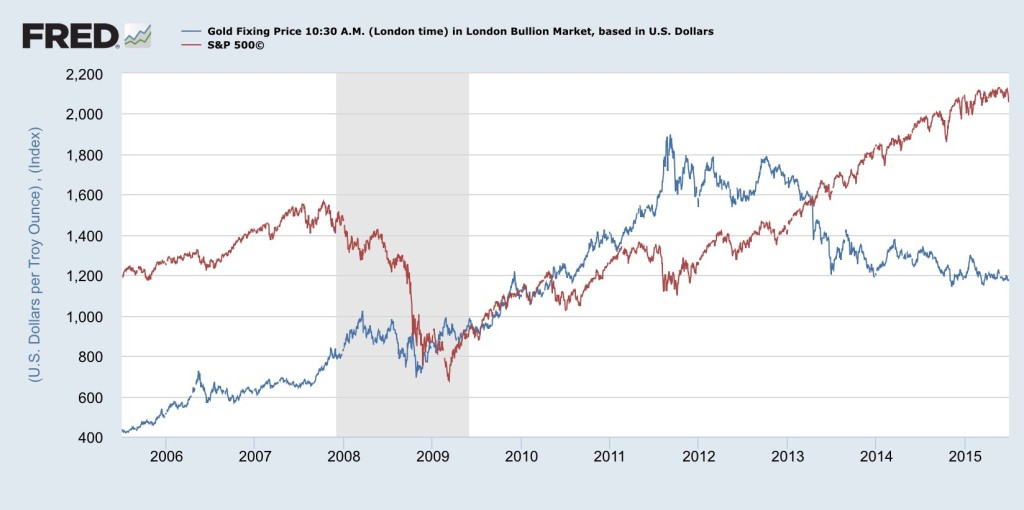Why Invest in Gold?

Ask the world’s wealthiest investors and they’ll tell you that diversification and balance are key to a strong portfolio. If your RRSP is heavily weighted in assets that are bound to the dollar, such as stocks, bonds, mutual funds and real estate, you are at risk of losing big when the next financial crisis hits. In 2008 in the U.S., it has been reported that the average portfolio of those nearing retirement lost 25% of its value. Some argue that the numbers are much higher, especially for those without any alternative assets or commodities in their portfolios and a heavy exposure to stocks.
The reality is that traditional investments like stocks, bonds and real estate require a degree of faith in the sustainability of the system and a certain level of optimism about the future of the economy. History has shown that the price of gold rises when such faith and optimism declines, which is inevitable from time to time. This makes gold an ideal financial instrument to diversify and balance an existing retirement or investment portfolio. A small amount of gold can greatly reduce the overall risk of your investments. It serves as a buffer against market volatility, a hedge against inflation and insurance against the possibility of an unforeseen market collapse.
According to a 2012 study at Johns Hopkins University, over the past century, the world has experienced 56 instances of hyper-inflation. In these situations prices climbed a minimum of 50% in a month. In extreme cases, like in post World War II Hungary, prices were doubling every 15 hours. When monetary systems collapse, gold stands strong. In less extreme cases, when monetary systems falter, the price of gold rises. It is an ancient universal currency that, unlike the national fiat currencies that are used today, cannot be diluted. The graph below shows the strong negative relationship between the strength of the U.S. dollar and the price of gold.
In recent history, the American dollar and the Euro have replaced gold as the world’s reserve currencies. The median age of all modern currencies is only 39 years and today every country uses a fiat currency. That is, the values of all currencies in circulation today are based on nothing but collective faith in the government and its ability to manage a sustainable economy. Gold, on the other hand, has been around and held a steady purchasing power for thousands of years as nations have come and gone.
In 2008, as the U.S. economy was nose diving, central banks around the globe began buying up gold. In fact, after Lehman Brothers collapsed, central banks went from being net sellers of gold to net buyers of gold. This shows a lack of faith in their foreign currency reserves, namely U.S. dollars and Euros.
Even if you don’t expect a large-scale collapse in the economy and believe that the likelihood that Canada will experience hyper-inflation is very low (which it is), gold is still a powerful hedge against stock market fluctuations. With equity markets reaching new highs amid growing economic uncertainty, it is unlikely that we will not see some large corrections in stock prices over the next few years. The graph below clearly illustrates the inverses relationship between the price of gold and stocks.
Of course, aside from the small amount of gold that gets consumed to make electrical components (about 10% of production from mines), gold is not a productive asset. Many have noted that we dig it out of the ground and lock it in underground vaults. Its value is largely psychological and speculative – a reflection of the level of fear and uncertainly in the markets. That does not mean that gold is a bad investment. It actually makes it an ideal tool to hedge risk.
Until 1971, the price of gold was dictated by the U.S. government and basically a function of U.S. exchange rates. After 1971, gold traded freely and its value has been established by the global marketplace. Since that year, an investment in gold would have returned approximately 3500% while the Dow Jones Industrial Average increased about 1500%. Between 2001 and 2011, the return on the Dow was around 11%, while the price of gold grew by nearly 550%. However, gold should be included in your RRSP to protect and diversify your retirement savings and not because you expect the price to appreciate. In the long run, the price of gold is expected to appreciate at the same rate as inflation.
Canadians should consider including some gold in their investment or retirement portfolios. Watch the following video where Kevin O’Leary talks about how he keeps 5% of his net worth in gold at all times.
John Paulson and Ray Dalio, both hedge fund managers and themselves billionaires, maintain positions in gold. Much of their success is based on the simple principle of diversification. Buying assets that do not correlate with one another means that regardless of what happens economically and politically, not all of their assets will head in the same direction. This is where gold becomes useful; when most assets head south, gold heads north.
Adding Gold to Your RRSP is a Good Idea
A handy way for Canadians to build a position in gold is add it to their retirement savings accounts. RRSPs (registered retirement savings plans) and self directed RRSPs offer tax incentives that encourage Canadians to build retirement portfolios. Limited contributions to your RRSP are tax-deductible until the age of 71 (the limit is found on your notice of assessment) and income earned or capital gains on assets that are held in an RRSP are not taxed. You can open an RRSP at most financial institutions and hold a variety of assets in these accounts. When Canadians turn 71, they are required to convert their RRSPs into RRIFs (registered retirement income funds). Mandatory withdrawals are then taxed like regular income.
If, like most Canadians, you are not saving more than the maximum annual RRSP contribution (about 18% of your total income), adding gold to your RRSP is likely the best strategy to both insure yourself against large scale economic failure and hedge your long term investments against the economy’s inevitable cyclical downturns. There are a number of investments you can make to include gold in your RRSP:
- gold & silver bullion bars
- stock in gold producing companies
- exchange traded funds (ETFs) linked to the price of gold
- ETFs linked to gold stock indexes
- mutual funds that strategically invest in gold

Will Your Retirement Weather the Next Financial Crisis?
Gold has been used as an inflation hedge and a way to preserve wealth for millennia. We partnered with Silver Gold Bull, Canada's top-rated gold company (with over 280,000 five-star reviews), to offer Canadians a low-cost and tax-advantaged way to buy gold and silver through an RRSP/TFSA or another retirement plan.
Request More Info
Website: www.SilverGoldBull.ca
Speak to an Expert: (877) 707-4707




Leave a comment